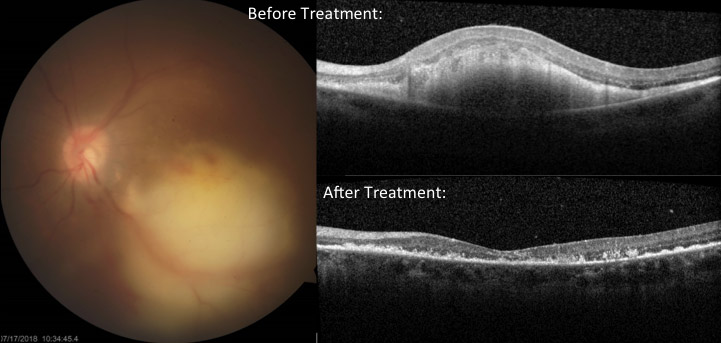University of Calgary

An otherwise healthy 43 year old female, originally from the Phillipines, living in Calgary for 38 years, presented to Emergency Department with a fever and flu- like symptoms. Blood cultures were positive for Klebsiella Pneumoniae. The patient was found to have a liver abscess, pneumonia and was started on Intravenous (IV) Ceftriaxone 1 gram BID. One week after admission to the hospital she began to notice decreased vision in her left eye. On ophthalmic evaluation her BCVA was 20/20 in the right eye and HM in the left eye. SLE of the left eye revealed an anterior chamber reaction of 1+ cells and 2+ vitriitis. Fundus examination of the same eye revealed a large chorioretinal abscess with hemorrhages affecting the macula. Right eye exam was remarkable for a cotton wool spot. The Ceftriaxone IV dosage was doubled and an intravitreal injection of Ceftazidime 2.25 mg/0.1 cc was administered. Nine days post-injection she had significant improvement of the chorioretinal abscess, however there was notable macular atrophy with Count Fingers as visual acuity.
Klebsiella species are gram-negative, encapsulated, anaerobic bacteria that are present in the normal nasopharyngeal and gastrointestinal flora. They are known to cause pneumonia and urinary tract infections. In recent years Klebsiella species have emerged as a prevalent cause of pyogenic liver abscesses in Asia. The reason for the predominance of this syndrome in the Asian population is unclear. It is associated with a 3 –11% incidence of endogenous endophthalmitis. This rate of ocular involvement is notably higher than with other systemic infections.
Siu LK1, Yeh KM, Lin JC, Fung CP, Chang FY., Klebsiella pneumoniae liver abscess: a new invasive syndrome. Lancet Infect Dis 2012;12: 881–87.
Sridhar J, Flynn HW, Kuriyan AE, Dubovy S, Miller D. Endophthalmitis caused by Klebsiella species. Retina (Philadelphia, Pa). 2014;34(9):1875-1881.
Jackson TL, Paraskevopoulos T, Georgalas I, Systematic Review Of 342 Cases Of Endogenous Bacterial Endophthalmitis, Survey of Ophthalmology (2014), doi: 10.1016/ j.survophthal.2014.06.002.